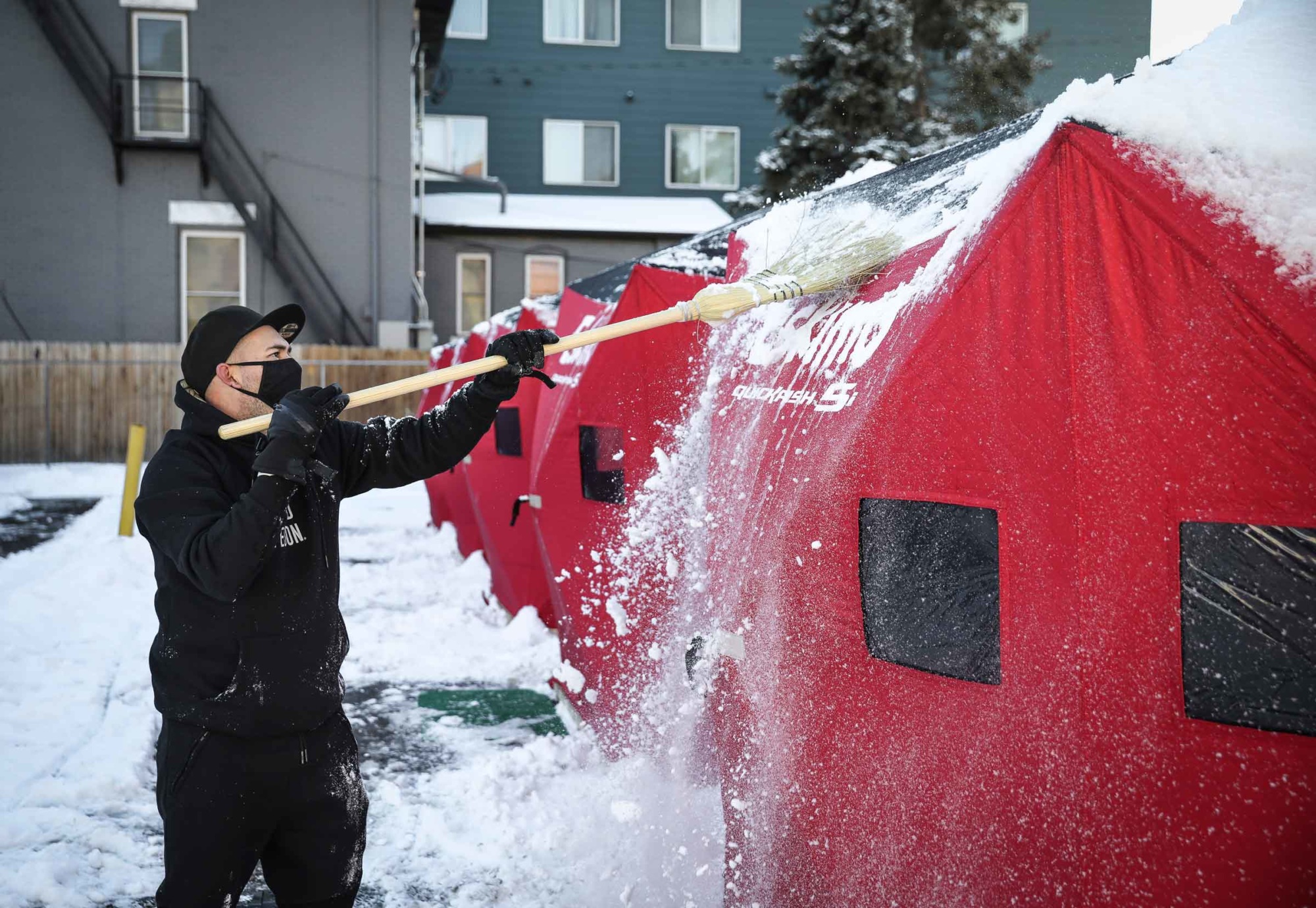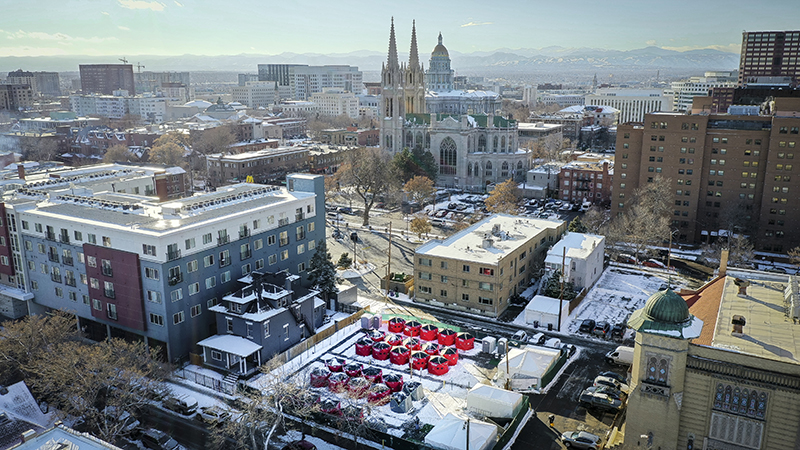
Robert Vazquez brushes snow off tents at a Colorado Village Collaborative sanctioned encampment in Denver on Dec. 15, 2020. Photos by Marc Piscotty / Special to The Colorado Trust
Robert Vazquez brushes snow off tents at a Colorado Village Collaborative sanctioned encampment in Denver on Dec. 15, 2020. Photos by Marc Piscotty / Special to The Colorado Trust
Platform tents on church parking lots. Sleeping in a safe outdoor space. A database with details on each person experiencing homelessness, accessible through an iPad. A massive construction push for affordable housing. And many more traditional shelters, fast.
Innovative, rapid-fire initiatives to assist the growing number of people experiencing homelessness have spread quickly across the Denver metro area, driven by supportive public votes and a renewed sense of “let’s get it done.”
Alongside these initiatives is a parallel push to systematically evaluate the results of each project and spread best practices, both to help more people and reassure voters, nonprofits and funders that their money is having an impact. Project backers are spending time and energy to consider what would constitute a success from their work, and an academic and professional culture of evaluation in homeless services has been born.
Still to be determined: What does “success” mean in this context, and who’s asking? Homelessness is one of the most visible signs of inequity in Colorado, yet it’s also one of the most complex social problems to tackle.
Welcoming 40 people into warm tents with good security and hygiene amid a pandemic could mark great success for that group. And yet more unauthorized, unsafe and inhumane encampments are likely to keep growing at exactly the same time, leaving little visible progress for the average citizen to appreciate.
The primary driver of homelessness currently in metro Denver, social service providers said, is that for decades, employment wage growth has not kept pace with rapid inflation in Denver housing prices or rents.
“We’re not going to solve America’s mass homeless problem through a couple of safe outdoor spaces,” said Cole Chandler, a leader of Colorado Village Collaborative, a group that helped organize two sanctioned platform-tent camps on private lots that opened in December in Denver’s Capitol Hill neighborhood.
“Unfortunately, the story that often comes out of homelessness reporting is that it’s a local issue, and that couldn’t be farther from the truth,” Chandler said. “The issues that we’re seeing are four decades in the making, related to drastic cuts in the federal housing budget in the 1980s that have never been replaced.
“Someone winds up in homelessness for multiple upstream failures. If we created safe spaces for every single person today, there would still be people who are homeless tomorrow because the system keeps producing that.”
Denver and Aurora are both adding to traditional shelter space with hundreds of new beds at renovated facilities. They may not add overall capacity compared to last year, though, as social distancing requirements from the pandemic means older shelters help fewer people.
In the meantime, some of Denver’s key social service providers and evaluators are keeping a close eye on the latest initiatives combating homelessness, and how the public might know if they are working:
Tent camps: Two city-sanctioned tent camps and safe spaces opened in December in parking lots donated temporarily by Capitol Hill churches, with zoning variances provided by the city for their planned six-month operations. Key selling points for the two tent camps—one for about 30 people, the other for 40—included providing more sanitary conditions and social distancing during the pandemic, and to improve upon large, unauthorized encampments nearby.
Colorado Village Collaborative, which previously opened Beloved Community Village, a north Denver tiny-home community for people experiencing homelessness, is running one of the camps. Chandler said positive outcomes are measurable, and will be tracked. Health officials will know if the tent residents stay virus-free and receive vaccinations; the residents will be connected to job placement and mental health services as needed, and some will move on to permanent affordable housing. Neighbors, police and emergency providers will also be asked what has changed from their viewpoints.
“We hope that what we do is better than the status quo for the neighborhood,” Chandler said.

The Colorado Village Collaborative is relying on parking lot space donated by churches for their encampments.
Safe parking lots: Many Denver and suburban churches have anecdotally seen growth in people living out of their cars, and seeking secure places to park and sleep overnight. The Colorado Safe Parking Initiative, an effort started by two Denver residents and backed by the University of Denver and Barton Institute for Community Action, is working with communities and local churches to identify lots where fewer than 10 cars could park overnight for their owners to sleep in relative security, leaving in the daytime.
Colorado Safe Parking Initiative officials told Westword it had set up approved lots in Broomfield, Longmont and Arvada, with a Golden location planned and negotiations ongoing inside Denver. In Longmont, a church opens a community room for the car owners to get meals, take showers and use computers to search for job and services.
Denver’s relatively new “czar” for homelessness and affordable housing, the Department of Housing Stability, says overnight parking lots will be allowed as part of the pandemic response, though it’s unclear how they would fit into long-term plans. Chief Housing Officer Britta Fisher said similar church or institutional parking lots are called for in the city’s request for proposals for new shelter and housing initiatives. “We’re getting close to decisions and announcements,” Fisher said in late December.
Safe parking will be evaluated, said Daniel Brisson, executive director of the Center for Housing and Homelessness Research at the University of Denver’s Graduate School of Social Work. The center and its graduate students took on a review of the safe lots when the university funded some community service projects, he said. Figuring out what “success” means from the parking lots is the first challenge: “We’re right now talking about the indicators we’re most interested in,” he said.
Shelter and housing tax: Denver voters in November easily passed a new sales tax boost, measure 2B, that will raise about $40 million a year to fund both innovation and expansion of proven housing solutions. Supporters want funded projects to include a mix of day and night shelters, speeding construction of affordable housing, integrated services, case management and newer ideas like tiny homes.
“We do know things that work,” Fisher said. “Denver has been a leader on supportive housing. Housing plus services works.”
Fisher mentioned the independently evaluated success of Denver’s social impact bond, where investors fund new supportive housing and reap profits from social services savings when people who were previously homeless experience fewer emergency medical services, detox stays and encounters with the criminal justice system.
Fisher acknowledged the challenge of convincing the public that homelessness solutions are worthwhile even as encampments and other visible signs of poverty continue to grow throughout Denver. “We measure success in things we can see. It’s much easier to see people who are not housed,” she said.
Nationally, the roots of homelessness are clear: Housing costs outpace wages. Studies have shown housing costs rising 40% since 2001, while the rate of income growth was essentially flat. Denver’s population growth and lack of building amplify that gap.
When people talk about shelter and affordable housing, Fisher said, they ask: Does it work? “It absolutely works for those who are able to access it,” Fisher said, “but we need more for people to access.”
Evaluation and public accountability are built into the 2B law, she added. Right now, the public can review the first-round action plan on the city’s website.
Homeless Management Information System: Metro-area governments, social agencies and nonprofits involved in homeless services are trying to provide seamless services and track needs by cataloging personal data on each person they serve. Communities receiving federal funds for homelessness are required to implement a coordinated information system.
One goal of the systems is to have “coordinated entry,” allowing shelters, for example, to share information on available space and suggest the best spot for someone checking in. The system can also track needs for mental health or substance abuse services, employment or training opportunities, and more. Agencies could look at aggregated data and see where more beds are needed most, at what time of year, or to see why some people leave permanent housing and return to homelessness.
In theory, Brisson said, academic researchers could also use the data, with individual identifiers removed, to evaluate successes or failures in services. Not all metro providers are fully invested in the system, though, he added, and failing to record use of services in one area can erode coordination.
“As a researcher, I can pretty clearly and openly say we have to be careful with the numbers we use about homelessness—it’s notoriously hard to acquire, and unreliable,” Brisson said.
Affordable housing push: Housing advocates for years have lamented that bureaucracy, zoning battles and not-in-my-backyard opposition slow the building of affordable units far below actual demand. Local governments have boosted the affordable units required in approving new development, and tax credits and bond money have piled up, but growth has been tepid.
Breaking the logjam is a top priority for Fisher and her department. Denver now has at least 13 affordable housing projects “in the pipeline,” according to a summary in The Colorado Sun, with construction on many having just started during the fall. More of the new units will be available to families rather than just single renters, and many will be priced at the “deeply affordable” level with higher subsidies.
The Colorado Coalition for the Homeless is combining two innovations in a just-announced housing complex next to its busy Stout Street Health Center. Aided by a new $3.1 million state grant, the coalition will develop a nine-story, $35 million building combining traditional affordable housing units with medical rehabilitation units, easing the transition of people experiencing homelessness from a hospital stay into permanent housing. Medical emergencies are often a key factor in the life instability that perpetuates homelessness, advocates have found.
Even as Denver tries to build more, faster, other market forces can undercut progress, Fisher noted. Each time an older housing unit is scraped or renovated for more upscale housing, Denver loses “naturally occurring affordable housing.”
And the other side of the affordability coin, Fisher said, is income. Higher wages make more units affordable to the home-seeker. Denver raising the minimum wage above state minimums is part of that solution, she said.
Large encampment outreach: Spontaneous, unauthorized encampments won’t disappear quickly even if many of the new initiatives prove successful, advocates said. Denver voters also rejected an end to the controversial “camping ban,” which allows the city to “sweep” illegal encampments and cite people experiencing homelessness for staying overnight in public spaces.
Denver has now contracted with the Colorado Coalition for the Homeless to create a special outreach team to contact and offer services to people living in camps that have more than a half-dozen tents or temporary structures. Urban Peak and St. Francis Center officials round out the outreach team.
The most immediate emergency is to protect packed-together tent residents from spreading the coronavirus among themselves and to others. The outreach team can connect them to federal hotel-room vouchers. Evaluation there is relatively easy, Fisher said: “We’ve had lower positivity and death rates than in other cities we’ve talked to.”
In the next phase of contacts, Fisher said, the outreach team can “find those folks in their hotel rooms and get them connected to long-term housing. And that’s the ultimate measure.”
Related stories: